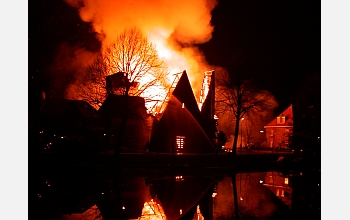News Release 07-171
Wildfire Letdowns and Wake-up Calls
After California wildfires, contrasting beliefs could drive recovery efforts

California wildfires destroyed more than 2,000 homes and caused $1 billion in fire damage.
November 19, 2007
This material is available primarily for archival purposes. Telephone numbers or other contact information may be out of date; please see current contact information at media contacts.
With damage estimates at more than $1 billion following recent October wildfires in the state of California, an important question comes into view: how will residents, business owners, insurance companies and community leaders respond?
Will people incorporate learning from the fires into decisions about whether, where and how to prepare for future fires?
Risk perception researchers funded by the National Science Foundation (NSF) say some people will experience "post-exposure letdown," while others experience a "post exposure wake-up call." They say some people will prepare for future fire events and some will not. Social scientists concede the finding is not surprising. They say the surprising thing is why -- why do people who experience the same event perceive it differently and respond with contrasting tendencies?
An NSF-supported risk perception research team examined the phenomenon after a 2003 wildfire in Canada. Robin Gregory, senior researcher at the Decision Research office in British Columbia, Canada and Joseph Arvai, a professor of Judgment & Decision Making at Michigan State University, East Lansing, Mich. led the team.
They surveyed two sets of homeowners who survived a series of devastating wildfires in Kelowna, British Columbia. The fires caused the evacuation of more than 45,000 Kelowna residents, destroyed more than 300 homes and many businesses, and resulted in three deaths.
One group of surveyed homeowners from Kelowna did not lose their homes but were at risk of future wildfires because they lived in or near highly wooded areas similar to places where fires recently occurred. This group experienced what researchers call a post-exposure letdown.
These residents actually felt safer after the fires because they perceived themselves to have been the victims of an unfortunate low-probability event, and that the worst was over. As a result, people experiencing a letdown were unlikely to invest in costly and/or time-consuming measures to lower their future risks or to consider response strategies for future wildfires.
Contrasting sharply with the "post-exposure letdown" was the feeling reported by the residents of Vernon, a community 32 miles north of Kelowna that was not affected by the fires but is situated in a similar urban-wildland interface area.
They reported what researchers call "post-exposure wake-up," characterized by greater risk awareness, heightened risk perception, and a strong desire to take action to better understand and lessen future exposure.
Individuals who experienced this were most likely to ensure that their homes had fire shelters and trimmed shrubs, bushes and trees to prevent encroachment upon homes. Members of this group also were likely to move to a different location.
"There's no doubt residents in California are experiencing the same reactions," said Louie Rivers, science assistant to NSF's decision, risk and management program. "Some people will take appropriate action to protect against future wildfires and some will rebuild on the same spot and take no action."
Researchers say these responses are likely to be found following any major, life-altering event, whether floods, earthquakes, hurricanes or volcano eruptions. They say knowing how to marshal the appropriate public response to protect against future damage to people and property is highly important.
Rivers said the research highlights the challenges faced by public officials such as wildfire managers, who wish to implement proactive interventions, such as prescribed burning, in areas that have recently experienced catastrophic fires.
"The results show that community leaders and public officials need to develop targeted, risk communication strategies immediately following an event for people experiencing postexposure letdown," Rivers said. "Communication strategies should emphasize the very real risk residents and business owners' face from future events and the need to prepare for such occurrences."
According to Rivers, it is important that officials dispel the intuitive yet inaccurate notion that "lightning does not strike twice."
-NSF-
Media Contacts
Bobbie Mixon, NSF, (703) 292-8485, email: bmixon@nsf.gov
Program Contacts
Louie Rivers, NSF, (703) 292-7323, email: lrivers@nsf.gov
The U.S. National Science Foundation propels the nation forward by advancing fundamental research in all fields of science and engineering. NSF supports research and people by providing facilities, instruments and funding to support their ingenuity and sustain the U.S. as a global leader in research and innovation. With a fiscal year 2023 budget of $9.5 billion, NSF funds reach all 50 states through grants to nearly 2,000 colleges, universities and institutions. Each year, NSF receives more than 40,000 competitive proposals and makes about 11,000 new awards. Those awards include support for cooperative research with industry, Arctic and Antarctic research and operations, and U.S. participation in international scientific efforts.
Connect with us online
NSF website: nsf.gov
NSF News: nsf.gov/news
For News Media: nsf.gov/news/newsroom
Statistics: nsf.gov/statistics/
Awards database: nsf.gov/awardsearch/
Follow us on social
Twitter: twitter.com/NSF
Facebook: facebook.com/US.NSF
Instagram: instagram.com/nsfgov


